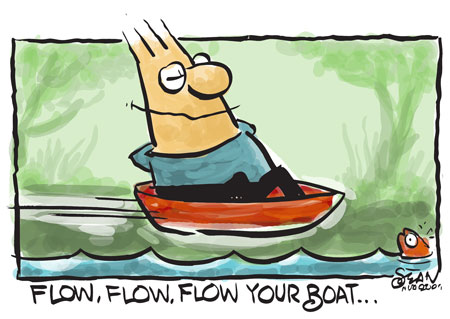
When you complete an article, you always have one of two reactions.
You think it rocks. Or you think it sucks. And you may be wrong on both fronts. You may think your article rocks, when in fact it sucks.
And vice versa.
So how do you know if your article works?
You would think you needed to read your article from start to finish, don’t you?
Quite the contrary: You don't read the article at all. You simply scan the article. And when you’re scanning, here’s what you’re looking for:
1) The headline.
2) The first fifty words.
3) The sub-headlines.
4) The ending.
That's it.
If you can see a flow from headline through the sub-headlines down to the ending, you know your article is working.
And the reason why it works is because it's answering all the questions that a reader would possibly ask. Now the only question is: When do you do this audit? Before or after you write the article?
That's a toughie, because your situation determines how you write an article.
On some days will write an article from start to finish based on a ‘response'. So if you're in a forum or a blog, and someone posts something, you'll find yourself all fired up and you'll write a detailed answer.
In many cases, your answer will have all the power and completeness of a finished article because you're trying to make sure you cover all the points. In such a situation, all you need to do is make the sub-headlines bold (if you don't have sub-headlines, invent them for the sake of the exercise). Then audit the article for flow. A touch here, a move there, and your article will be ready.
What if you're starting up from the ground up?
If you are starting up from ground zero, you need structure. The structure comprises of the headline, the first fifty words, the sub-headlines that answer the questions ‘What? How? Why? When? Can you give me proof? Can you give me an example?’ And then the ending paragraph of the article. If you follow this systematic approach, your article will flow a lot better than most written material.
But let's take an example using an actual article
Headline: Power of Connectors in Copywriting
First fifty words: You've started reading a newsletter. And before you know it, you're at 500 words. Then at 750 words. And hurtling past 1000 words. How on earth did you end up reading so much, when all you wanted to do was skim through the article? The answer is in the connectors in copywriting.
The sub-headlines:
– So what are the connectors in copywriting?
– Do you see what's happening?
– A connection is like a bridge
– Why is this slip-sliding so very important?
– Example, Example:
– Personal Experience:Ending: If you noticed, the content in this piece didn't have enormous style. It lacked stories. It lacked metaphors. And yet it made a distinct point. It taught you something very powerful. Of course, the biggest reason you continued to read, was because of the connectors. Every movie, article or sales letter that's brilliant always has a connection. Create the connection and your reader will read from start to finish!
See the flow in that article?
Once you have flow in the sub-headlines, what you have is solid structure.
And that's what makes an article exciting: the ability to answer all the questions of the reader in a systematic, easy flowing manner.
That's your internal audit system. That's how you know if your article really rocks. Or sucks.
Way better than just ‘wondering’ if it rocks. Or sucks.
Start. Stop. Start. Stop. The biggest frustration with writing is it drives you crazy.
Yet writing is a “language” like everything else. Learn the structure and you can learn to write without the frustration and faster than every before.
Click here for Free Goodies: Article Writing mini-booklet that helps you quickly improve your article writing

Sean,
Nice adjustments to the outline. I see what you were talking about on our chat. Makes things easier.
Easy’s good. =)
Sean I found this article really striking and helpful too. I dunno what flow is but I know what it feels like and it’s what I try to get to when I blog or write articles.
You’ve almost given a recipe here to get into it.
I found your example article, mmm, puzzling. I could feel the flow and looked for the clever tricks I thought you must be playing…
🙂
…it seemed artless, “no hands Mom” writing that carried me along effortlessly.
Exciting stuff and a promise of a great month!
Headline, intro, structure and close. It all makes perfect sense.
I’m a new member at Teaching Sells and I heard an interview you did with Sonia Simone as a bonus in the site. I really learned a lot in the interview and can see where I can make some changes in my writing. Glad I found your site, thank you for the info you provide here.
Reba